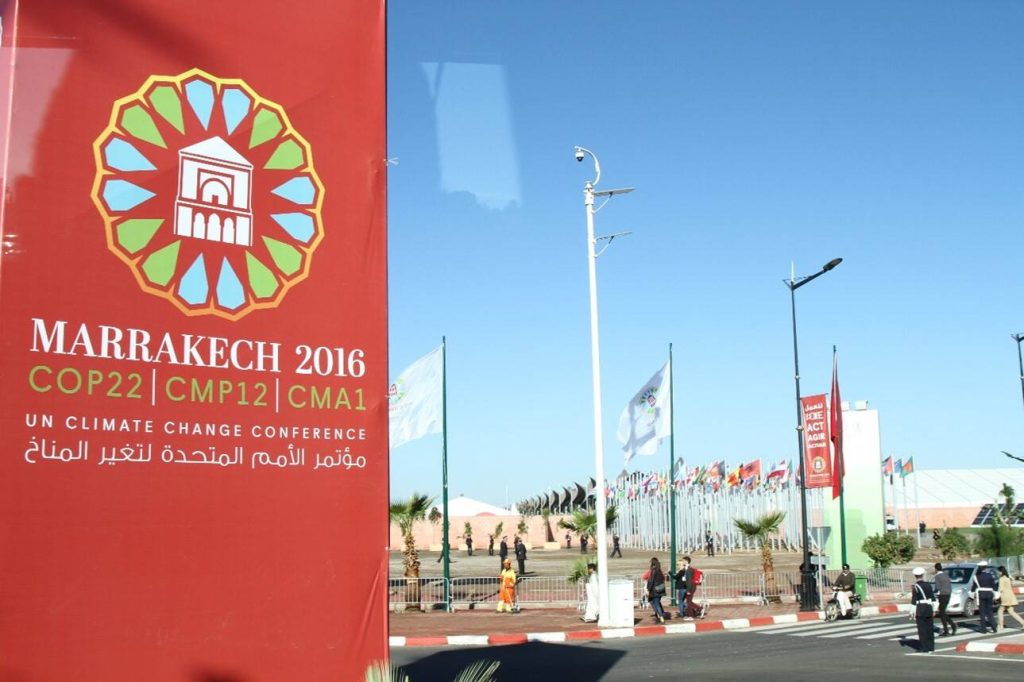Introduction: Strengthening Global Resolve at COP22
The 22nd Conference of the Parties (COP22) to the United Nations Framework Convention on Climate Change (UNFCCC), held in Marrakech, Morocco, in November 2016, signified a defining moment in the journey toward global climate action. Following the landmark Paris Agreement in 2015, COP22 was positioned as the “COP of Action,” aimed at converting high-level commitments into tangible steps for mitigating climate change and enhancing resilience against its impacts. This shift toward concrete action was critical, especially given the timing of political changes, such as the election of U.S. President Donald Trump, whose stance on climate policy generated uncertainty. Nonetheless, COP22 underscored an irreversible global commitment to tackling climate change, placing emphasis on a practical framework and timeline for implementing the Paris Agreement’s targets, with a goal to finalize the rulebook by 2018.
COP22 emphasized the need for immediate, coordinated action to address the climate crisis, with a specific focus on developing clear mechanisms for financing, transparency, adaptation, and non-market approaches. The conference laid the groundwork for transitioning from the conceptual promises made in Paris to substantive action, reflecting a strong international determination to create a sustainable, low-carbon future. By fostering collaboration among state and non-state actors, COP22 aimed to advance a more inclusive climate movement, emphasizing the principles of “further, faster, together” to underline the urgency of collective action.
From Paris Pledges to Marrakech Action Plans
COP22 served as the first major opportunity for countries to operationalize the Paris Agreement, which had rapidly gained force in 2016, supported by more than 111 countries that collectively account for three-quarters of global emissions. This overwhelming support underscored a shared commitment to tackling climate change, but it also highlighted the need for clear, structured guidelines to translate these broad commitments into achievable goals. The Moroccan Presidency of COP22 pursued an ambitious agenda, guiding discussions on essential themes such as climate finance, transparency, adaptation, and resilience. As part of this agenda, the Marrakech Partnership for Global Climate Action was launched to facilitate climate efforts before 2020, promoting cooperative action among nations, regions, and businesses. However, critics noted that the initiative lacked measurable benchmarks, underscoring the challenges of implementing broad climate policies on a global scale.
In operationalizing the Paris Agreement, COP22 also placed significant emphasis on Nationally Determined Contributions (NDCs), which outline each country’s specific goals for emissions reduction and adaptation. NDCs play a critical role in the Paris Agreement’s transparency framework and the global stocktake process, which is designed to assess collective progress every five years. This system is intended to encourage countries to review and strengthen their commitments regularly, ensuring that progress remains on track. Furthermore, COP22 prioritized adaptation strategies, especially for developing nations facing the most severe climate impacts, and established guidelines for adaptation communications, which help countries convey their adaptation needs and plans effectively.
Climate Finance: Supporting Developing Nations and African Needs
One of the most pressing themes at COP22 was climate finance, a vital component in enabling developing nations to achieve their climate goals. For many African nations and other developing countries, financing climate adaptation and mitigation efforts requires external support due to limited domestic resources. As such, COP22 reaffirmed the commitment to mobilize $100 billion annually by 2020, a target originally established in the Paris Agreement to assist developing countries in their transition to low-carbon economies. This funding is critical for African nations as they work to transform their economies and strengthen infrastructure to adapt to climate change.
While the $100 billion target remains essential, experts at COP22 argued that it might be insufficient to address the full scale of the climate crisis, with adaptation needs alone projected to require between $140 billion and $300 billion annually by 2030. COP22 called for a comprehensive roadmap to ensure that climate finance is both predictable and accessible, allowing developing nations to plan effectively and attract additional investments. Moreover, climate finance at COP22 was recognized as a shared responsibility, with developed countries bearing the primary burden under the Paris Agreement but emerging economies, such as China and Brazil, as well as the private sector, expected to make meaningful contributions. Multilateral development banks, including the African Development Bank, have made strides in “climate-proofing” their projects, and COP22 emphasized the importance of ensuring that these institutions remain committed to supporting the low-carbon transition.
COP22 also highlighted the complexity of the existing climate finance architecture, which consists of more than 50 different climate funds and is often criticized for its inefficiencies and high transaction costs. Many of these funds are too fragmented to serve Africa’s large-scale needs, focusing on small projects rather than comprehensive national programs. To address this structural issue, the Green Climate Fund, a new mechanism operationalized at COP22, committed to a balanced approach by dividing funds equally between adaptation and mitigation efforts. However, COP22 revealed the need for further reforms to streamline climate finance mechanisms and ensure that resources reach the countries and communities that need them most.
Loss and Damage: Supporting the World’s Most Vulnerable Populations
Acknowledging the disproportionate impact of climate change on vulnerable communities, COP22 revisited the Warsaw International Mechanism (WIM) for Loss and Damage, a framework established to assist communities facing displacement and other irreversible impacts due to climate-related disasters. COP22 adopted a new five-year work plan for the WIM, which focuses on minimizing displacement risks and supporting adaptation in highly vulnerable regions. Additionally, a Task Force on Displacement was created to provide recommendations on mitigating climate-induced displacement by COP24 in 2018, aiming to enhance the support provided to countries most affected by climate change.
This focus on loss and damage is particularly relevant for African nations, which often lack the resources to manage climate-related disasters effectively. Rising sea levels, climate variability, and extreme weather events threaten millions of lives and livelihoods, especially in sectors such as agriculture and tourism. At COP22, the United Nations Environment Programme (UNEP) estimated that adaptation costs could rise significantly by 2030, highlighting the urgency of closing the climate finance gap for adaptation. The attention to loss and damage at COP22 represented a critical step in acknowledging the unique challenges faced by vulnerable populations and working toward equitable solutions.
Engaging Non-State Actors in Climate Action
COP22 underscored the role of non-state actors, such as local governments, corporations, and civil society groups, in driving climate action. Non-state actors are essential to building momentum and implementing sustainable practices at all levels of society. Initiatives like the Under2 MOU coalition and the Science Based Targets Initiative, which engage cities, regions, and businesses in emissions reduction efforts, exemplify the proactive role that non-state actors can play, often outpacing national governments in their climate commitments. At COP22, the launch of the Marrakech Partnership for Global Climate Action provided a platform for coordinating these efforts, reinforcing the role of diverse stakeholders in advancing climate goals. Partnerships like the NDC Partnership, supported by civil society organizations and NGOs, offer technical expertise and policy guidance, particularly to developing countries seeking to implement effective climate strategies.
Technological Innovation and Long-Term Climate Planning
COP22 placed a strong emphasis on innovation and clean technology as necessary drivers for achieving the deep decarbonization required to meet climate goals. Countries at the conference emphasized the importance of advancing technologies in areas such as renewable energy, energy efficiency, and electric transportation. Initiatives like Mission Innovation, which committed to doubling global investment in clean energy research, and the Breakthrough Energy Coalition, backed by high-profile investors, showcased a collaborative effort to foster sustainable solutions for global climate challenges.
In addition to technological advancements, COP22 promoted long-term climate planning, encouraging countries to submit mid-century strategies aimed at achieving low-carbon economies by 2050. Canada, Germany, Mexico, and the United States led by presenting their mid-century strategies, offering a blueprint for sustainable development that balances economic growth with environmental responsibility. These strategies align with the Paris Agreement’s long-term vision of limiting global temperature increases to well below 2°C, acknowledging that sustainable infrastructure and other critical investments made today will have a lasting impact on future generations.
Conclusion: Toward a Climate-Resilient Future
COP22 concluded with a sense of unity and urgency, reinforcing the global commitment to the Paris Agreement despite political uncertainties. The conference underscored the need for ambitious timelines, adequate financial support, and transparent mechanisms to ensure that climate action remains effective and equitable. While significant challenges remain—especially in meeting financial targets and addressing pre-2020 commitments—COP22 laid a solid foundation for continued progress toward a resilient, low-carbon future. By fostering collaboration among nations, communities, and stakeholders, COP22 advanced a global resolve to combat climate change, underscoring the need for both immediate action and strategic, long-term planning. Through the guiding principles of “further, faster, together,” COP22 highlighted the urgent need for a united approach to building a sustainable, climate-secure world for all.
Image Credit:
WWF
Sources:
Center for Climate and Energy Solutions. (2017, October 27). COP 22 Marrakech – Center for Climate and Energy Solutions. https://www.c2es.org/content/cop-22-marrakech/#:~:text=The%20Marrakech%20conference%20capped%20an,climate%20pollutants%20known%20as%20HFCs.
COP 22 Summary report 7–18 November 2016. (2022). In IISD Earth Negotiations Bulletin. https://enb.iisd.org/marrakech-climate-change-conference-cop22/summary-report#brief-analysis-marrakech-climate-change-conference
Norwegian Refugee Council [NRC]. (2016, November). COP22: Time for action. NRC. https://www.nrc.no/globalassets/pdf/briefing-notes/cop22-time-for-action/cop22-time-for-action.pdf
What happened at COP22 in Marrakech? Four key themes. (2016). The Carbon Trust. https://www.carbontrust.com/news-and-insights/insights/what-happened-at-cop22-in-marrakech-four-key-themes
At COP22, it is important to ensure that climate finance meets Africa’s needs. (2024, September 10). World Economic Forum. https://www.weforum.org/stories/2016/11/at-cop22-it-is-important-to-ensure-that-climate-finance-meets-africa-s-needs/



